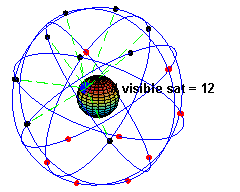Bestand:ConstellationGPS.gif
Uiterlijk
ConstellationGPS.gif (240 × 192 pixels, bestandsgrootte: 485 kB, MIME-type: image/gif, herhalend, 300 frames, 30 s)
Bestandsgeschiedenis
Klik op een datum/tijd om het bestand te zien zoals het destijds was.
| Datum/tijd | Miniatuur | Afmetingen | Gebruiker | Opmerking | |
|---|---|---|---|---|---|
| huidige versie | 6 mrt 2008 16:56 |  | 240 × 192 (485 kB) | Shushruth | {{Information |Description={{en|A simulation of the original design of the GPS space segment, with 24 GPS satellites (4 satellites in each of 6 orbits), showing the evolution of the number of visible satellites from a fixed point (45ºN) on earth (conside |
Bestandsgebruik
Dit bestand wordt op de volgende pagina gebruikt:
Globaal bestandsgebruik
De volgende andere wiki's gebruiken dit bestand:
- Gebruikt op ar.wikipedia.org
- Gebruikt op ar.wikiversity.org
- Gebruikt op ast.wikipedia.org
- Gebruikt op as.wikipedia.org
- Gebruikt op ba.wikipedia.org
- Gebruikt op be-tarask.wikipedia.org
- Gebruikt op bg.wikipedia.org
- Gebruikt op bn.wikipedia.org
- Gebruikt op bs.wikipedia.org
- Gebruikt op ca.wikipedia.org
- Gebruikt op cs.wikipedia.org
- Gebruikt op da.wikipedia.org
- Gebruikt op de.wikipedia.org
- Gebruikt op de.wikinews.org
- Gebruikt op el.wikipedia.org
- Gebruikt op en.wikipedia.org
- Surveillance
- Military satellite
- Nuclear weapons delivery
- User talk:El pak
- Time to first fix
- GPS signals
- Wikipedia:Featured picture candidates/February-2008
- Wikipedia:Featured picture candidates/Animated representation of the orbit of the GPS system
- Talk:Global Positioning System/Archive 6
- User:Boundarylayer/sandbox
Globaal gebruik van dit bestand bekijken.

